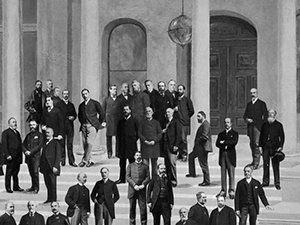County council reports
 Surrey County Council met for the first time as Provisional Authority on 24 January 1889. Its first meeting as the new local authority for Surrey was on 1 April. Although members could put resolutions to County Council meetings the predominant method of working was by considering the reports of the County Council committees, receiving them and adopting by resolution their recommendations. The reports to a meeting of the County Council were bound in paper (for a long period before 1974 the covers were yellow and the reports were commonly known as 'Yellow Books').
Surrey County Council met for the first time as Provisional Authority on 24 January 1889. Its first meeting as the new local authority for Surrey was on 1 April. Although members could put resolutions to County Council meetings the predominant method of working was by considering the reports of the County Council committees, receiving them and adopting by resolution their recommendations. The reports to a meeting of the County Council were bound in paper (for a long period before 1974 the covers were yellow and the reports were commonly known as 'Yellow Books').
The committee reports include proposed new policy developments, including responses to legislation, for example, Technical Education from 1891 and Elementary Education from 1903. In some cases the reports contain regular operational reports from officers (for example inspectors of weights and measures), and, especially in the early years, approvals of payments, often of quite small sums. The reports also include a variety of bye-laws, or orders, which required the approval of County Council, appointments of senior officers, and in some cases quite junior officers, and increases in salary. Chief Officers' appointments were sometimes voted on in County Council, and the numbers of votes for each candidate may be given in County Council minutes in the early years. The committee reports show how departments were organised.
The reports are particularly useful at times and in areas of rapid change: for example, the varied attempts to improve roads to meet ever-increasing road traffic; the reports from the first Medical Officer of Health on public sanitation in various parts of rural Surrey; responses to war-time needs. Some officers regularly submitted reports containing interesting details such as Inspectors of Weights and Measures on the various defaults of local traders. The reports are generally uninformative on the daily working of services throughout the County - day-to-day life of schools, for example - although a great deal can be deduced from the reports, especially when the need for change prompted a review of the background to the proposed change.
The major committees in 1889 were:
- Selection, which nominated members to serve on the other committees
- Finance
- General Purposes Sanitary (later Public Health and Hygiene)
- Highways (later Highways and Bridges)
- Lunatic Asylum (later Lunatic Asylums)
The Technical Education Committee was created in 1891 and was replaced by the Education Committee in 1903. By 1920 there was a rapid growth in the number and range of committees:
Agricultural Executive Ancient Monuments
- Selection
- County Rate
- Diseases of Animals
- Finance
- General Purposes
- Highways and Bridges
- Land Drainage
- Lunatic Asylums
- Maternity and Child Welfare
- Mental Deficiency
- Music and other Licensing
- Parliamentary
- Public Control
- Public Health and Housing
- Reformatories
- Small Holdings and Allotments
- Education
- Insurance
- Local Pension
- Smallpox Hospital
Relationship of the reports to council and committee minutes
County Council minutes are quite full in the first years, including, for example, lists of members voting for the various options for locating a new County Hall. Although they soon become less detailed, consisting mainly of references to the acceptance of committee reports, they should not be disregarded.
Committee minutes are often very detailed, including many routine matters (junior appointments, small payments) which would not be reported to County Council. Some committees, notably the Education Committee, had a number of sub-committees. The Education Committee produced its own series of printed reports from sub-committees to the main committee for many years, and these provide greater details than is found in the reports to County Council.
See also:
- The grand opening of County Hall, Kingston, 13 November 1893
- The wartime bombing of County Hall, Kingston
- School dinners in Surrey
Image
- Section of photograph entitled 'First Surrey County Council, 1889' (reference 2525/1)

